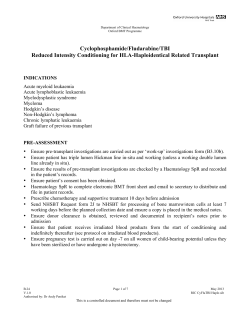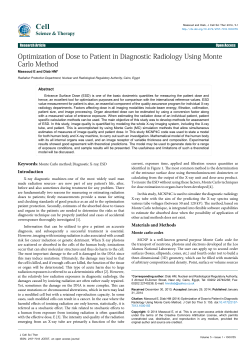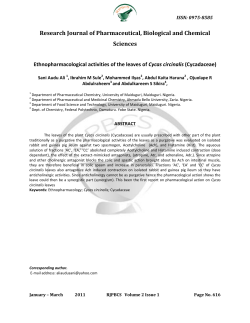
Introduction to patient dose quantities, measurement approaches and effective dose
Introduction to patient dose quantities, measurement approaches and effective dose estimates in diagnostic and interventional radiology procedures Dose Datamed 2 WP4 TRAINING COURSE Sofia 19-20 May 2011 Hannu Järvinen Radiation and Nuclear Safety Authority (STUK) hannu.jarvinen@stuk.fi Effective dose, E E = ∑ wT H T = ∑ wT T T ∑w R DT , R R wT weighting factor for organ or tissueT (ICRP) DT,R mean absorbed dose to organ or tissue T HT equivalent dose to organ or tissue T Unit: sievert (Sv), 1 Sv = 1 J kg-1 Effective dose, E • Effective dose [ICRP, 1991] has been used as a convenient indicator of overall risk-related exposure of the patient from an x-ray examination • It essentially takes account of non-uniform body exposures and the organs and tissues now known to be sensitive to deleterious radiation effects by estimating the average whole body dose that would result in the same total radiation-induced cancer risk as the non-uniform body exposure. Collective effective dose • Population doses have been expressed in terms of the annual collective effective dose (S) • It takes account of the number of people exposed to a particular source; in practice: Population dose S = Σ i Number of Procedures i x Average effective dose for procedure i Collective effective dose • Since the collective effective dose depends on the size of the population exposed to a particular source, it is often more useful to use the annual average per caput dose (i.e. the annual collective dose averaged over the entire population), particularly when – studying trends in population doses with time – or when comparing the population doses from different countries. Patient dose quantities • Effective dose cannot be measured directly in the patient. Patient doses (as well as Diagnostic Reference Levels (DRLs) ) are not usually expressed in terms of effective dose, but in terms of more easily measured patient dose quantities. • Effective dose can be estimated – by computational methods when the imaging parameters are known – by using convertion factors from patient dose quantities into effective dose. Practical exercizes Patient dose quantities: General radiography/fluoroscopy • Incident absorbed dose, incident air kerma Ki • Entrance surface dose (ESD), entrance surface air kerma Ke • Dose area product (DAP), Air kerma-area product PKA Incident air kerma, Ka,i ”Tube output” Incident air kerma Ka,i Ka = Ka/PIt n 1m d= FSD Entrance surface dose (ESD) Includes backscatter from patient Entrance surface dose, ESD (Entrance skin Dose) FSD Dose area product (DAP) Dose area product, DAP or Air kerma area product, KAP, PKA FSD Area A Dose D DAP ≈ D · A DAP = ∫∫ D air dx dy ⋅ dx ⋅ dy Use of ESD and DAP • ESD or DAP can be used as the practical dose quantity for single radiographs. • For more complex examinations consisting of a number of radiographs and/or fluoroscopy, the total DAP accumulated over the complete examination is the preferred quantity. Determination of ESD Calculation of ESD from tube output ESD = nKa (U,F) (100cm/FSD)2 Pit BSF tube output (mGy/mAs) at a distance of 100 cm from the focus, with high voltage of U and total filtration F FSD focus-to-skin distance (cm) PIt tube current-time product used (mAs) BSF back scatter factor n Ka(U,F) IAEA CoP for Dosimetry in Diagnostic Radiology (TRS 457) Measurement of DAP • Either DAP-meter (plane parallel ionization chamber) or computational display for DAP (based on beam parameters) • DAP-meter can be removable or fixed DDM2/hj 19 May Removable DAP-meter mounted in front of collimator DAP display unit in control room Fixed DAP-meter inside the housing Diamentor M4 1,5 2,5 mmAl 1,45 Calibration factor = Measured DAP/ Indicated DAP 1,4 3 mmAl 4 mmAl 5 mmAl Calibration factor 1,35 4 mmAl+0,1 mmCu 1,3 4 mmAl+0,2 mmCu 1,25 1,2 1,15 1,1 1,05 From Paula Pöyry 2006 1 0 1 2 3 4 5 6 HVL (mm Al) HVL. mmAl DDM2/hj 19 May 7 8 9 10 Patient dose quantities: Mammography • Incident air kerma Ki • Mean glandular dose (MGD) Mammography • The only reason for wanting to estimate the effective dose in mammography is to complete the calculation of the total collective effective dose from all types of x-ray examination. • For risk estimates in mammography it is far better to use the mean glandular dose and age/sex-specific risk factors for radiation-induced breast cancer. Mammography • The mean glandular dose (MGD) can be calculated from the incident air kerma (Ka,i) by means of Monte Carlo based conversion factors provided for – various radiation qualities (tubevoltage, anode and filter material, and half value layer) and – breast thicknesses and composition (percentage of glandular tissue and fat) • An average value for the conversion factor of 0.18 might give a reasonable accuracy when the purpose is to assess the population dose Mammography • The latest mammography units automatically provide calculated values of the MGD (in units of mGy) • Otherwise the incident air kerma can be measured with an ionization chamber. • In the UK, a software tool has been published (freely available) that automatically calculates mean glandular doses from information on – the x-ray tube output, – the exposure conditions and – relevant patient parameters. Patient dose quantities: Computed tomography • • • • • CT Dose Index free-in-air (CTDIa) or CT Air Kerma Index free-in-air (C K) Weighted CT Dose Index in the standard CT dosimetry phantoms (CTDIW) or Weighted CT Air Kerma Index in the standard CT dosimetry phantoms (C K,PMMA,w) Volume CT Dose Index (CTDIvol) CT dose-length product (DLP) or CT air kerma-length product (PKL,CT]) Standard CT phantom of PMMA (IEC) Computed Tomography Dose Index (IEC and EC) CTDI100 = 1 +50 mm D( z )dz ∫ NxT −50 mm D (z) dose along the axis of rotation (a line normal to the scan plane) for a single rotation T nominal section thickness N number of tomographic sections produced in a single rotation DDM2/hj 19 May Weighted CTDI100 CTDIW= ⅓ CTDIc + ⅔ CTDIp CTDIc is the CTDI from one rotation, along the central axis of the CT dosimetry phantom and CTDIp is the CTDI from one rotation, along a line parallel to the central axis of the CT dosimetry phantom and 1 cm depth below the phantom surface DDM2/hj 19 May CTDI vol and DLP • CTDIvol = CTDIw / CT pitch factor • CT pitch factor = Δd/ (NxT) – Δd: distance moved by the patient support between serial scans or per 360° rotation for helical scanning • DLP = CTDIvol x L (= DLPw) – L: scan length Area = ∫D(z)dz pencil shaped z ION CHAMBER average dose z dosimetric reading (Dmeas) corresponds to the average dose in the ionization chamber volume DLP = Dmeas. x length of chamber (mGy cm) (or directly DLP-dosemeter) CTDI vol and DLP • CTDIvol = CTDIw / CT pitch factor • CT pitch factor = Δd/ (NxT) – Δd: distance moved by the patient support between serial scans or per 360° rotation for helical scanning • DLP = CTDIvol x L (= DLPw) – L: scan length Thank you for your attention! t is soon time for Midnight sun
© Copyright 2025





















